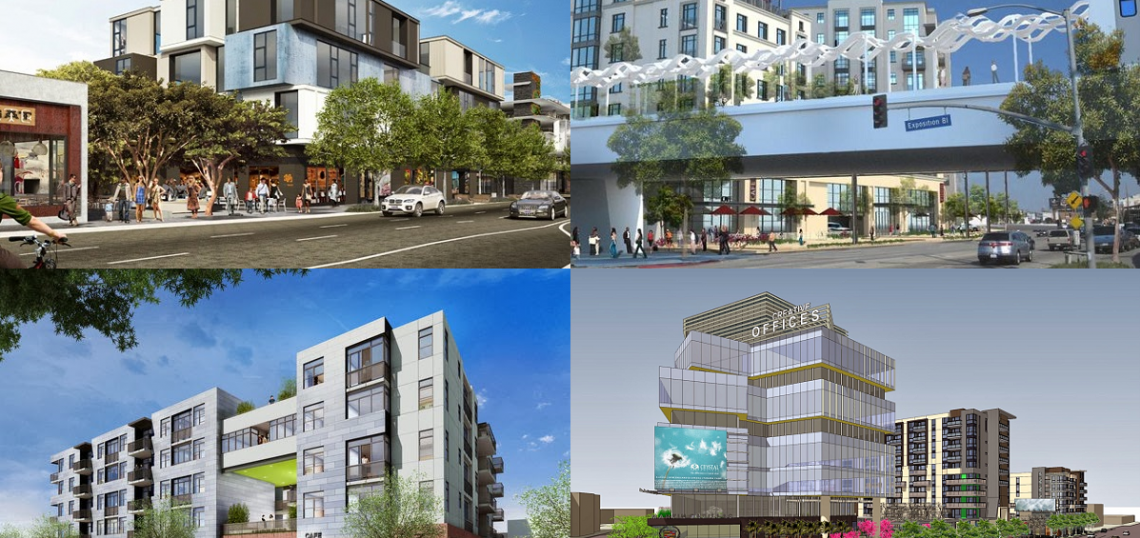A sea change is underway on the Westside, where multiple neighborhoods are reorienting themselves around phase two of the $1.5 billion Expo Line. The 6.6-mile light rail extension, spanning between Downtown Santa Monica and Culver City, has already spurred an uptick in development activity near several station sites. However, due to the freight railway which once traversed the Expo Line's route, many station-adjacent parcels feature zoning that is inconsistent with the walkable, mixed-use communities that the city seeks to create. Thus, LADCP has partnered with Metro to create the Los Angeles Transit Neighborhood Plan (LATNP), a $7.5 million campaign to shape development policy around the city's newest light rail lines. This undertaking will repurpose several blocks surrounding the Westwood/Rancho Park and Expo/Sepulveda Stations, as detailed in a document from the Westside Neighborhood Council.
Although the Westwood/Rancho Park Station lies at the heart of a single-family zone, bustling Pico Boulevard is located roughly a quarter-mile north, with several properties ripe for development. Under LATNP's plan, the northern side of Pico between Overland and Bentley Avenues would be rezoned as RAS4, allowing for the construction of new residential-retail buildings up to five stories in height. The same changes would be applied to the opposite side of the street, on a segment bounded by Military Avenue and the Westside Pavilion shopping mall. As it happens, developers may already be teeing up to make this vision a reality. A rumor originating last week on Reddit alleges that the beloved Apple Pan restaurant may be amongst the first properties on the chopping block.
Further west at the elevated Expo/Sepulveda Station, LATNP proposes to rezone properties between Exposition and Pico Boulevards as "hybrid industrial," with an emphasis on jobs. The hybrid industrial label facilitates increased population density near the rail station, as encouraged by smart growth principles, but also preserves a cache of the city's decreasing supply of job-creating industrial land. The latter issue was frequently cited by opponents of the Casden West LA development, which will replace an active cement plant located next to the station.
Residential development is permitted on up to 30% of land zoned as hybrid industrial-jobs emphasis, with the remainder devoted to some variation of light manufacturing, office and retail uses. LATNP's proposal also calls for the segment of Pico Boulevard between Military Avenue and Sepulveda Boulevard to receive this treatment.
Plans are slightly different one block east on Military Avenue, which LATNP intends to rezone between Ayres Avenue and Exposition Boulevard. This half-block section of Military would be zoned as hybrid industrial-residential emphasis, allowing for residential development on 70% of the property and job-generating uses for the remaining 30%.
All land bounded by Sepulveda, the 405 Freeway, Pico and Olympic Boulevard would be classified as "new industry," under LATNP's proposal. Other city-owned properties adjacent to the rail line itself, specifically those between Overland Avenue and Westwood Boulevard, will remain as open space to accommodate the Expo Greenway.
Though it is not included in the above presentation, LATNP also proposes changes for the neighborhood surrounding another Expo Line Station at Bundy Drive. In particular, LATNP's plans would rezone much of the land to the north of the station for new industry or hybrid industrial uses. A significant portion of the single-family district south of Exposition Boulevard would be upzoned to facilitate multi-family residential construction. Properties fronting Bundy Drive would be zoned as RAS4, allowing for residential buildings with ground-floor commercial space.
These changes may come just in the nick of time, as several developers have targeted nearby properties in anticipation of the Expo Line. A half-block north of the station, developer Hudson Pacific Properties is in the midst of construction on Element LA, a 284,000 square foot office campus which will become the headquarters of Riot Games. Next door, the family-owned Martin Automotive Group intends to convert its longtime Cadillac dealership into a mixed-use development featuring office, residential and retail uses. These improvements will add to an already substantial employment district along the Olympic corridor, which is home to a small cluster of mid-rise office buildings.
- Notice of Agenda: October 9, 2014 (Westside Neighborhood Council)
- Spring 2014 Outreach Presentation (LATNP)






